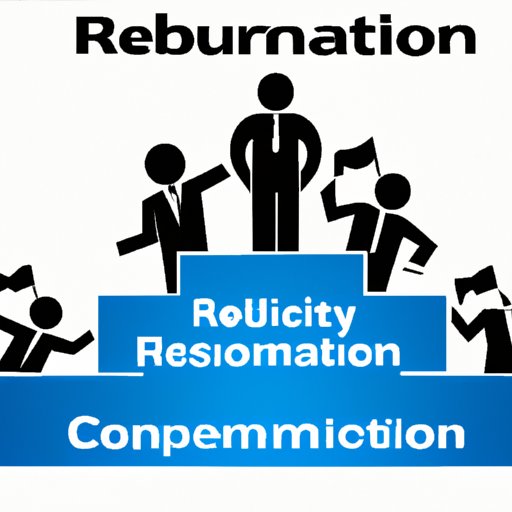Introduction
Organizational culture refers to the shared values, beliefs, attitudes, and behaviors that characterize a given organization. It is the set of rules and regulations that govern the way employees interact with each other and with customers. A strong organizational culture can have a positive impact on employee performance, retention rates, business success, and customer satisfaction.

How Organizational Culture Affects Employee Performance
Organizational culture has a direct influence on employee performance. There are several ways that a strong company culture can improve employee motivation and engagement, communication and collaboration, and productivity.
Employee Motivation and Engagement
A strong organizational culture can increase employee motivation and engagement by providing a sense of purpose and belonging. Employees who feel valued and appreciated are more likely to be productive and motivated. When employees are given clear goals and expectations, they are more likely to stay engaged and motivated to achieve them.
Communication and Collaboration
A positive organizational culture also encourages open communication and collaboration among employees. When employees feel comfortable communicating their ideas and opinions, they are more likely to work together to find solutions to problems and come up with innovative ideas. This leads to improved efficiency and productivity.
Productivity
A strong organizational culture can also lead to improved productivity. When employees feel valued and supported, they are more likely to take initiative and put in extra effort to get things done. Additionally, when employees are encouraged to take risks and think outside the box, they are more likely to come up with creative solutions that can lead to increased productivity.
Impact of Organizational Culture on Retention Rates
Organizational culture also has a significant impact on employee retention rates. If a company has a strong culture of respect and appreciation for its employees, it is more likely to retain and attract talented individuals. There are several factors that contribute to job satisfaction and professional growth opportunities, which can help to strengthen a company’s culture and increase employee retention.
Job Satisfaction
Employees who feel valued and appreciated are more likely to be satisfied with their jobs. When employees are given recognition for their hard work and achievements, they are more likely to stay with the organization. Additionally, if employees are given the opportunity to develop professionally, they are more likely to remain with the company.
Professional Growth Opportunities
A strong organizational culture also provides employees with opportunities for professional growth. When employees are given the chance to learn new skills and advance their careers, they are more likely to stay with the organization. Additionally, if employees are provided with meaningful work and challenging tasks, they are more likely to remain engaged and committed to the organization.
Work-Life Balance
A positive organizational culture also promotes a healthy work-life balance. When employees are given the opportunity to take time off, participate in team building activities, and pursue hobbies outside of work, they are more likely to feel fulfilled and satisfied with their jobs. This can help to reduce employee turnover and increase retention rates.

Link Between Organizational Culture and Business Success
Organizational culture also has a direct link to business success. A strong company culture can improve a company’s reputation, financial performance, and customer relationships.
Positive Reputation
A strong organizational culture can help to build a positive reputation for a company. When customers see that a company values its employees and treats them with respect, they are more likely to trust the company and view it favorably. This can lead to increased customer loyalty and higher sales.
Improved Financial Performance
A positive organizational culture can also lead to improved financial performance. When employees are motivated and engaged, they are more likely to be productive and efficient. This can lead to increased profits and better returns on investment.
Enhanced Customer Relationships
A strong organizational culture can also help to enhance customer relationships. When customers feel valued and appreciated, they are more likely to become loyal customers and recommend the company to others. This can lead to increased sales and improved customer satisfaction.
Role of Leadership in Establishing an Effective Company Culture
Leadership plays a critical role in establishing an effective organizational culture. Leaders must set clear goals and expectations, communicate values, and create a positive working environment.
Setting Goals and Expectations
Leaders must set clear goals and expectations for employees. They should provide guidance and support to ensure that employees understand what is expected of them and have the tools and resources needed to succeed.
Communicating Values
Leaders must also communicate the company’s values and vision. They should make sure that all employees understand the company’s mission and are working toward the same goals. This helps to create a unified culture that is focused on achieving success.
Creating a Positive Working Environment
Leaders should also strive to create a positive working environment. They should provide recognition for hard work, encourage collaboration and innovation, and promote a healthy work-life balance. When employees feel valued and appreciated, they are more likely to be productive and motivated.

Relationship Between Organizational Culture and Customer Satisfaction
Organizational culture can also have a direct impact on customer satisfaction. When employees are motivated and engaged, they are more likely to go the extra mile to meet customer needs and provide excellent service. Additionally, a positive organizational culture can help to build trust between customers and the company, which can lead to long-term customer relationships.
Meeting Customer Needs
Organizational culture can play an important role in meeting customer needs. When employees are empowered to make decisions and take initiative, they are more likely to find solutions to customer problems quickly and efficiently. This can lead to increased customer satisfaction.
Building Trust
A strong organizational culture can also help to build trust between customers and the company. When customers feel valued and appreciated, they are more likely to trust the company and view it favorably. This can lead to increased customer loyalty and higher sales.
Implementing Service Excellence
Finally, a positive organizational culture can help to implement service excellence. When employees are provided with the tools and resources needed to provide excellent service, they are more likely to go above and beyond to meet customer needs. This can lead to increased customer satisfaction and improved customer relationships.
Conclusion
Organizational culture is an important factor influencing employee performance, retention rates, business success and customer satisfaction. Establishing a strong company culture can have numerous benefits, such as increased employee motivation and engagement, improved communication and collaboration, increased productivity, and improved customer relationships. Additionally, leadership plays an important role in setting goals and expectations, communicating values, and creating a positive working environment. By implementing an effective organizational culture, companies can reap numerous rewards, including improved financial performance, enhanced customer relationships, and increased customer satisfaction.
(Note: Is this article not meeting your expectations? Do you have knowledge or insights to share? Unlock new opportunities and expand your reach by joining our authors team. Click Registration to join us and share your expertise with our readers.)
